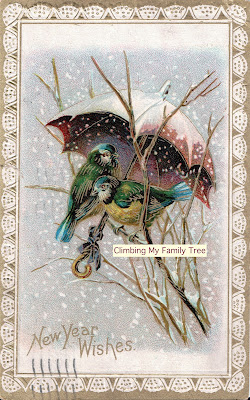I admit it--I get a bit teary-eyed thinking of the babes in my family tree who died too young. I want their names to live on, by putting them on public family trees and making sure their burial places are recorded.
How Miriam wound up in hubby's family tree
Today I'm focusing on Miriam Louise Wise (1925-1926). This little girl's father was Clifford "Buck" Wise (1895-1963) and her mother was Edith Macklin Wise (1897-1947). After Miriam's early death, Clifford and Edith were happy to welcome a second daughter, Janice (1927-1988), bringing light back into their lives, as I know from family letters.
Clifford was widowed in 1947 and the following year, he married my father-in-law's first cousin, Edith Eleanor Baker (1901-1989), who became a devoted and loving stepmom to Janice. This connection with the Wise family is how little Miriam Louise Wise wound up in my hubby's family tree.
Making sure Miriam is remembered
Miriam's parents (both on my family tree already) are buried in Acacia Masonic Memorial Park Cemetery in Mayfield Hts, Ohio, and memorialized on Find a Grave. But until now, I hadn't looked carefully for Miriam's final resting place.
By searching for "more Wise Memorials" in the same cemetery, I came upon a memorial page for "Marian Wise," birth/death unknown (see image above). The plot is exactly where Miriam's parents are buried.
My conclusion: Marian is surely Miriam. Interestingly, the obit in the Fremont Daily Messenger (which I've ordered*) calls her Mariam Louise Wise, but the Ohio death index lists her as Miriam. Family letters also call her Miriam.
Her now revised memorial page is on Find a Grave.
This reflects edits I submitted to the memorial page's manager, correcting Miriam's name and including her dates. I also posted an image of Miriam's name in the death index. And I posted Miriam's sweet baby photo, as shown.
Miriam is already on the tree at FamilySearch and on two Ancestry public trees, courtesy of relatives in the Wise family. I'm adding her to all my Wood family trees over time.
It's comforting that Miriam will not be forgotten, because her name and dates are documented in more than one place by more than one person. Rest in peace, little Miriam.
* Turns out, the obit does name this baby correctly as Miriam Louise Wise. She died of "telescoping of the bowels" (causing dangerous blockage). Doctors operated, unsuccessfully, sad to say.
This post is my "May Day" for The Genealogy Blog Party, 2022.





















